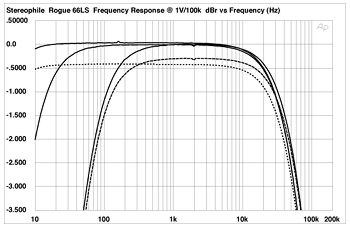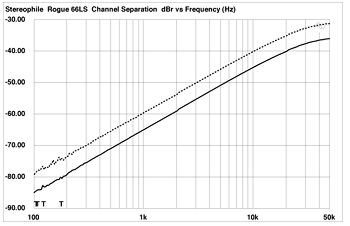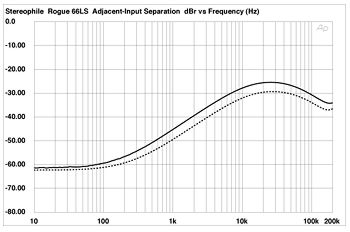| Columns Retired Columns & Blogs |
Rogue Audio 66LSR preamplifier Measurements
Sidebar 3: Measurements
Although the Rogue 66LSR was tested using its "CD" inputs, all of its inputs appear identical, including the one marked Phono. The unity-gain setting of the volume control was 3:00, and the gain with the volume control at its maximum measured very much lower than specified: 9.1dB rather than 23dB. In addition, the second pair of outputs was inoperative in either passive or active mode. As all the operating voltages appeared to be correct, no fuses were blown, and there was no sign of "cooked" components, I assumed that the preamp's main signal path was operating correctly.
The 66LSR inverted absolute polarity. Its input impedance varied from a very high 200k ohms at 1kHz and below to a still-high 157k ohms at 20kHz. Its output impedance measured 600 ohms at 20kHz and 620 ohms at 1kHz, rising to a high 3k ohms at 20Hz.
As a result, the bass rolled off early into very low impedances (fig.1, bottom trace below 1kHz). But into 10k ohms—perhaps the lowest load the 66LSR will see in normal use—the low frequencies extended to -0.5dB at 22Hz, which is fine. At the other end of the spectrum, the highs were 0.5dB down at 20kHz, which may be slightly audible. Note the poor channel-matching in this graph: 0.5dB, which was with the balance control set to its detented central position.

Fig.1 Rogue 66LSR, frequency response at 1V output with volume control at maximum gain into 100k ohms (top below 100Hz), 10k ohms (middle), and 600 ohms (bottom). (Right channel dashed, 0.5dB/vertical div.)
Channel separation (fig.2) was spoiled by capacitive coupling—perhaps across the volume control or the tubes—indicated by the 6dB/octave rise with frequency. Perhaps more important, there was significant leakage from one pair of inputs to the adjacent pair with the undriven input open circuit (fig.3). Even though this is a worst-case situation, unless you want to hear an FM station accompanying a CD, for example, unused inputs should be shorted with plugs.

Fig.2 Rogue 66LSR, channel separation with volume control at its maximum, from top to bottom: R-L, L-R (10dB/vertical div.).

Fig.3 Rogue 66LSR, adjacent-input separation (10dB/vertical div.)
- Log in or register to post comments




































